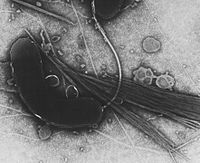
Photo from wikipedia
Abstract Opportunistic pathogenic bacteria readily proliferate in live feed cultures used to feed marine fin fish larvae. As a consequence, larvae cultures fed infected live feed can suffer devastating larvae… Click to show full abstract
Abstract Opportunistic pathogenic bacteria readily proliferate in live feed cultures used to feed marine fin fish larvae. As a consequence, larvae cultures fed infected live feed can suffer devastating larvae mortalities. Antibiotics are still used to control these pathogenic bacteria, but due to the risk of antibiotic resistance, sustainable alternatives are required. Phage therapy and probiotic bacteria are examples of alternatives which are currently being developed. However, regrowth of phage tolerant bacteria or reduced inhibition by probiotic bacteria in non-axenic systems, have been seen. The purpose of this study was to investigate if combining the broad-host-range vibriophage KVP40 and probiotic bacteria Phaeobacter inhibens DSM17395 would result in an enhanced inhibitory effect against the fish pathogenic Vibrio anguillarum and protection of live feed and cell lines. The combined and individual treatments were tested in non-axenic live feed systems (i.e. Tetraselmis suecica microalgae and Artemia salina brine shrimps) obtained from a commercial larval rearing unit. Further, we determined if the probiont and/or phages could protect CHSE-214 fish cell line challenged with V. anguillarum. P. inhibens, KVP40 and their combination reduced vibrio counts in the T. suecica cultures with one to two orders of magnitude below inoculum level. Combining KVP40 and P. inhibens resulted in a lower level of V. anguillarum than using the probiont alone. In the Artemia cultures, P. inhibens alone or in combination with KVP40 reduced vibrio counts and Artemia mortality relative to the control, while KVP40 alone only delayed vibrio growth and Artemia mortality. Combining KVP40 and P. inhibens caused an immediate killing of V. anguillarum, however, it did not provide extra inhibitory potential and only little extra protection of Artemia, as compared to using only P. inhibens. Our results demonstrate that probiotic bacteria and phages in commercial, non-axenic live feed can reduce levels of fish pathogenic Vibrio. The combinations of phage and probiont only resulted in a marginal improved pathogen reduction, however, this could and should be further optimized.
Journal Title: Aquaculture
Year Published: 2019
Link to full text (if available)
Share on Social Media: Sign Up to like & get
recommendations!